Union soldier — Don’t I look sharp!
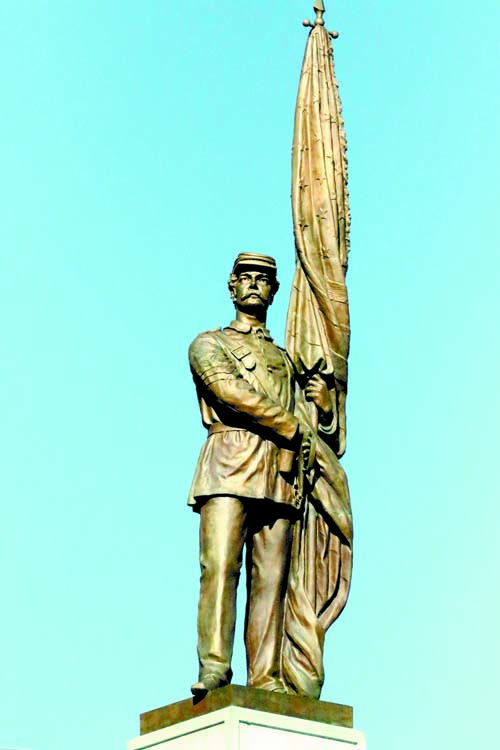
By Wayne E. Rivet
Staff Writer
As two women looked up at the Union soldier statute as it glistened in the morning sunlight, one remarked, “I didn’t know he has a mustache.”
The finer details were lost over the years as weather and environmental factors tarnished the bronze statue, leaving it tired-looking due to shades of black and green.
Anthony Tafuri brought the soldier back to life.
For the past few weeks, the local sculpture and artist climbed up several levels of scaffolding and used a variety of techniques to “restore” the statue to its once grand condition.
“We were very lucky to get this work done,” Bridgton Town Manager Bob Peabody said. “Everything came together.”
The monument — known as the Cleaves Soldiers Monument — was created by Hallowell Granite Company and erected in 1910. It was presented to the town by Henry B. and Nathan Cleaves, and dedicated on July 21 to Bridgton’s Sons, who defended the Union in 1861–1865.
Lester Baker, formerly of Harrison and owner of Pro Point Restoration of Pittsfield, N.H., approached the town in the spring about restoring the granite monument at no cost.
“We figured it was a good time to get the rest of the monument done. It was the perfect time, especially with all the work coming up to improve Main Street,” Peabody added. “We are grateful for Pro Point’s generous donation.”
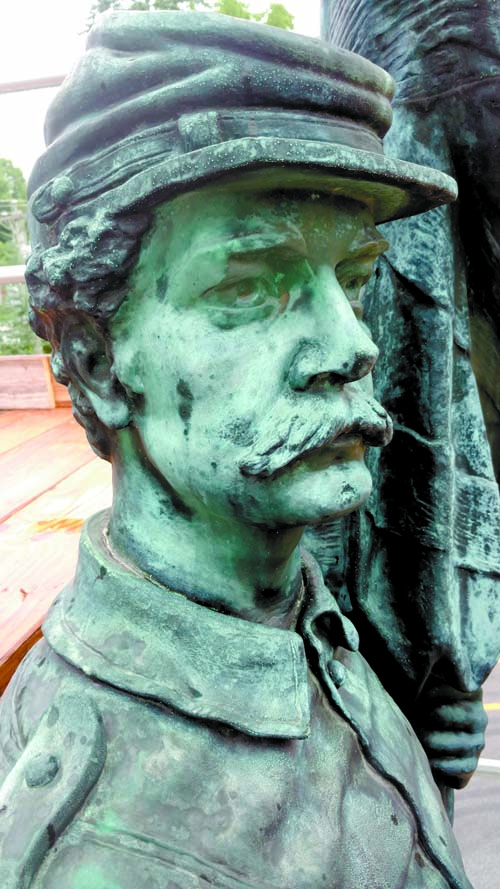
Peabody budgeted $16,000 for monument restoration, covering the costs of scaffolding, a porta-pottie and Tafuri’s expenses.
A graduate of Portland School of Art and Southern Illinois University at Carbondale (master’s degree in Fine Art), Tafuri started the project by snapping photographs of the monument’s condition before “restoration,” as well as after.
“You can see that it was really corroded. The black color especially is a bad sign. Once that starts, the surface can start to become very pitted,” Tafuri said.
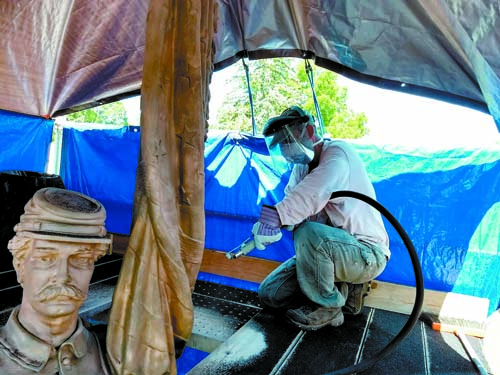
The first step was to sandblast the whole sculpture to bring the bronze right down to bare metal.
“Luckily, I did not have to do any welding. Sometimes, water condensing and freezing inside the bronze can start to form cracks, particularly where the individual bronze castings were fastened together,” he said. “This sculpture consists of at least nine pieces. What was interesting to see was the old foundry’s methods. You could see where sections were riveted together, evidence of the casting process where there were minor defects fixed, etc.”
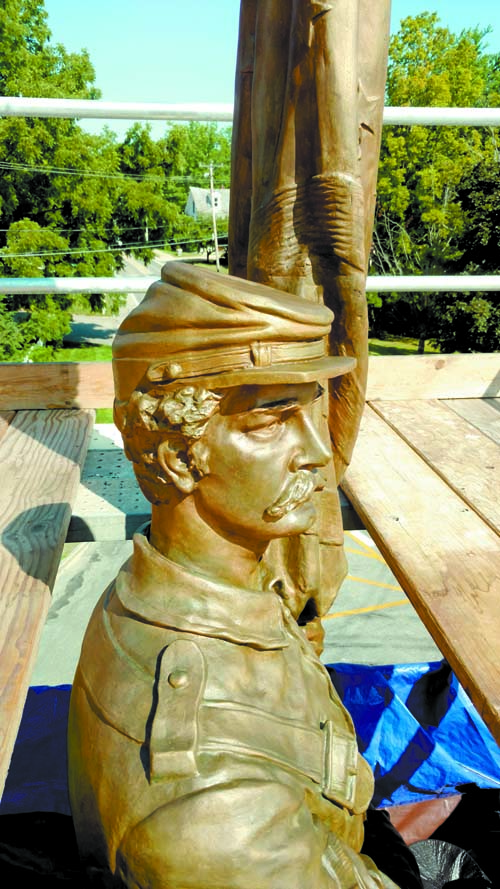
After sandblasting, Tafuri and his son, Davin, buffed the whole sculpture to bring a sheen back to the metal.
“This step is important because the patina (a thin layer that forms on the surface of copper, bronze and similar metals — tarnish produced by oxidation or other chemical processes or change of a surface through age and exposure) in the next step would look dull if it was not shiny. The patina is transparent, so the metal reflects light from underneath,” Tafuri explained. “The patina itself was comprised of two different types of acids — ferric nitrate and cupric nitrate. The metal is warmed with a torch, then the patinas are painted on. Ferric gives a brown, and I went light on the cupric for some subtle greens.”
After the patina, the whole sculpture was sprayed down with a baking soda solution to neutralize the acid. It was then cleaned off. (The acid is fairly mild, he noted). The final step was to apply a sealer.
“I used Incralac, which is by far the best for copper-based alloys. I also added a matting agent, otherwise Incralac has a high gloss,” Tafuri said.
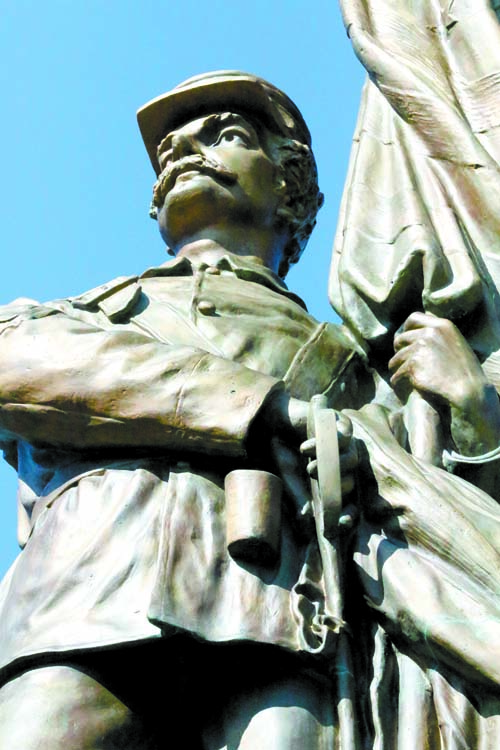
Tafuri has been a part of other projects across Maine, including working with Conservation Technical Associates to restore “Our Lady of Victories” in Monument Square in Portland and Pro Point in restoring a Civil War monument in Augusta.
“That (Our Lady of Victories) was an interesting project. I had to model, cast and install missing bronze portions of the monument, including an eagle in the sailors group, parts of the soldier’s clothing and equipment,” he noted.
Tafuri started studying art in 1985.
“I became interested in sculpture right away. I have always responded to working with my hands and exploring new media,” he said.
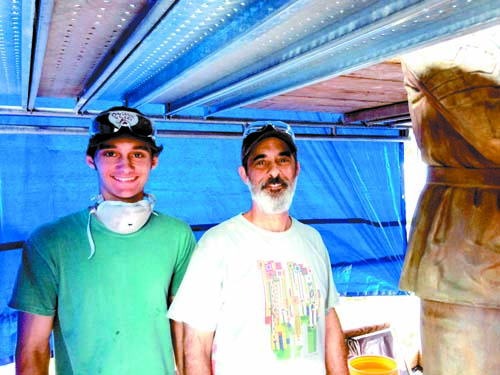
Tafuri has done a lot of work with bronze and aluminum casting, as well as blacksmithing, welding, woodworking and mold-making.
“I am currently working toward being in my studio fulltime. I undertake sculpture commissions, both public and private, and work with wrought iron, making railings, furniture, chandeliers, etc.” Tafuri added.
Being restored to his original glow, if this old Union soldier could smile, he certainly would.

